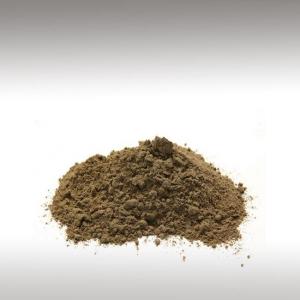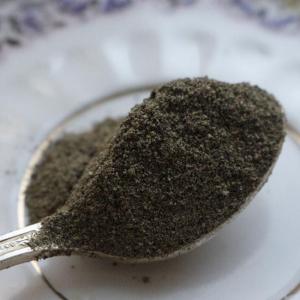
BLACK PEPPER POWDER (PIPER NIGRUM) - INGREDIENTS

BASE / GENERAL DATA
Information submited: March 30, 2015 Modified: May 29, 2018 By: OperaDreamhouse
Black Pepper (Piper Nigrum) is a flowering vine in the family Piperaceae, cultivated for its fruit, which is usually dried and used as a spice and seasoning.
The Pepper plant is a perennial woody vine growing up to 4 metres in height on supporting trees, poles, or trellises. It is a spreading vine, rooting readily where trailing stems touch the ground.
The leaves are alternate, entire, 5 - 10 cm long and 3 - 6 cm across. The flowers are small, produced on pendulous spikes 4 - 8 cm long at the leaf nodes, the spikes lengthening up to 7 - 15 cm as the fruit matures.
The fruit, known as a Peppercorn when dried, is approximately 5 millimetres in diameter, dark red when fully mature, and, like all drupes, contains a single seed.
Peppercorns, and the ground Pepper derived from them, may be described simply as Pepper, or more precisely as Black Pepper (cooked and dried unripe fruit), Green Pepper (dried unripe fruit) and white Pepper (ripe fruit seeds).
Black Pepper is produced from the still-green unripe drupes of the Pepper plant. The drupes are cooked briefly in hot water, both to clean them and to prepare them for drying. The heat ruptures cell walls in the Pepper, speeding the work of browning enzymes during drying.
The drupes are dried in the sun or by machine for several days, during which the Pepper around the seed shrinks and darkens into a thin, wrinkled black layer.
Once dried, the spice is called Black Peppercorn. On some estates, the berries are separated from the stem by hand and then sun-dried without the boiling process.
Black Pepper is native to south India, and is extensively cultivated there and elsewhere in tropical regions. Currently Vietnam is the world's largest producer and exporter of pepper, producing 34% of the world's Piper Nigrum.
Black Pepper is the world's most traded spice.
The word "Pepper" has its roots in the Dravidian word for Long Pepper, Pippali. Ancient Greek and Latin turned Pippali into the Latin Piper, which was used by the Romans to refer both to Black Pepper and Long Pepper, as the Romans erroneously believed that both of these spices were derived from the same plant.
Black Peppercorns were found stuffed in the nostrils of Ramesses II, placed there as part of the mummification rituals shortly after his death in 1213 BCE. Little else is known about the use of Pepper in ancient Egypt and how it reached the Nile from South Asia.
Pepper (both long and black) was known in Greece at least as early as the 4th century BCE, though it was probably an uncommon and expensive item that only the very rich could afford.
Chemical structutre:
The spiciness of Black Pepper is due to the chemical Piperine, not to be confused with the capsaicin that gives fleshy Peppers theirs.
One tablespoon (6 grams) of ground Black Pepper contains moderate amounts of Vitamin K (13% of the Daily Value or DV), iron (10% DV) and Manganese (18% DV), with trace amounts of other essential nutrients, protein and dietary fibre.
Pepper loses flavour and aroma through evaporation, so airtight storage helps preserve its spiciness longer. Pepper can also lose flavour when exposed to light, which can transform Piperine into nearly tasteless isochavicine.
The Pepper plant is a perennial woody vine growing up to 4 metres in height on supporting trees, poles, or trellises. It is a spreading vine, rooting readily where trailing stems touch the ground.
The leaves are alternate, entire, 5 - 10 cm long and 3 - 6 cm across. The flowers are small, produced on pendulous spikes 4 - 8 cm long at the leaf nodes, the spikes lengthening up to 7 - 15 cm as the fruit matures.
The fruit, known as a Peppercorn when dried, is approximately 5 millimetres in diameter, dark red when fully mature, and, like all drupes, contains a single seed.
Peppercorns, and the ground Pepper derived from them, may be described simply as Pepper, or more precisely as Black Pepper (cooked and dried unripe fruit), Green Pepper (dried unripe fruit) and white Pepper (ripe fruit seeds).
Black Pepper is produced from the still-green unripe drupes of the Pepper plant. The drupes are cooked briefly in hot water, both to clean them and to prepare them for drying. The heat ruptures cell walls in the Pepper, speeding the work of browning enzymes during drying.
The drupes are dried in the sun or by machine for several days, during which the Pepper around the seed shrinks and darkens into a thin, wrinkled black layer.
Once dried, the spice is called Black Peppercorn. On some estates, the berries are separated from the stem by hand and then sun-dried without the boiling process.
Black Pepper is native to south India, and is extensively cultivated there and elsewhere in tropical regions. Currently Vietnam is the world's largest producer and exporter of pepper, producing 34% of the world's Piper Nigrum.
Black Pepper is the world's most traded spice.
The word "Pepper" has its roots in the Dravidian word for Long Pepper, Pippali. Ancient Greek and Latin turned Pippali into the Latin Piper, which was used by the Romans to refer both to Black Pepper and Long Pepper, as the Romans erroneously believed that both of these spices were derived from the same plant.
Black Peppercorns were found stuffed in the nostrils of Ramesses II, placed there as part of the mummification rituals shortly after his death in 1213 BCE. Little else is known about the use of Pepper in ancient Egypt and how it reached the Nile from South Asia.
Pepper (both long and black) was known in Greece at least as early as the 4th century BCE, though it was probably an uncommon and expensive item that only the very rich could afford.
Chemical structutre:
The spiciness of Black Pepper is due to the chemical Piperine, not to be confused with the capsaicin that gives fleshy Peppers theirs.
One tablespoon (6 grams) of ground Black Pepper contains moderate amounts of Vitamin K (13% of the Daily Value or DV), iron (10% DV) and Manganese (18% DV), with trace amounts of other essential nutrients, protein and dietary fibre.
Pepper loses flavour and aroma through evaporation, so airtight storage helps preserve its spiciness longer. Pepper can also lose flavour when exposed to light, which can transform Piperine into nearly tasteless isochavicine.

SPIRITUAL PRACTISES DATA

MEDICINE / HEALTH DATA

BEAUTY / COSMETICS DATA

FOOD / COOKING DATA
COMMENTS
No comments.
Newest mixtures containing Black Pepper Powder (Piper Nigrum):

Base Golden milk masala
May 12, 2015



